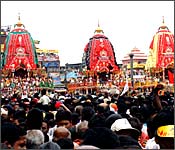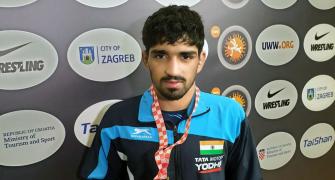Janmashtami, Lord Krishna's birthday, was celebrated this year on August 16.
The day was marked by Raasleela performances, fasting, feasting and prayer.
rediff.com tours some of India's most famous Krishna temples:
Dwarka, Gujarat
Krishna's capital, Dwarka, located on the Kutch coast, is one of the four holy cities -- chardham -- of India. Visitors by the thousands flock to this town of narrow streets and temples during Janmashtami.
The impressive, beautifully carved Dwarkadeesh temple soars above the melee of pilgrims. The temple, which consists of 60 columns, is five storeys high and its majestic spire climbs a further 60 m into the sky. The inner sanctum or the Nij Mandir, the faithful believe, dates back to 500 BC. Non-Hindus are allowed in the temple if they complete some formalities.
East of central Dwarka is the tiny, pretty Rukmini temple, dedicated to Krishna's consort.
A short trip away from Dwarka, via Okha, is Bet Dwarka, the spot where it is thought Krishna died. Several temples are located on this island in the Gulf of Kutch.
Mathura, Uttar Pradesh
 By the banks of the Yamuna at Mathura, on a stormy night at the beginning of time, Krishna was born, and Mathura became one of the most holy cities of India. But history dealt Mathura a severe blow and the age-old Krishna shrines did not survive the invading hordes. That has not detracted in any way from its magnetic pull with pilgrims. The land of the Krishna legend, Brajbhoomi, draws the devout by the thousands especially during Janmashtami.
By the banks of the Yamuna at Mathura, on a stormy night at the beginning of time, Krishna was born, and Mathura became one of the most holy cities of India. But history dealt Mathura a severe blow and the age-old Krishna shrines did not survive the invading hordes. That has not detracted in any way from its magnetic pull with pilgrims. The land of the Krishna legend, Brajbhoomi, draws the devout by the thousands especially during Janmashtami.
On the ruins of one of the oldest temples of Mathura -- Kesava Deo -- stands Aurangzeb's Katra Masjid (also called the Shahi Masjid). The vestiges of the shrine can be still seen and nearby is one of the city's more important temples -- the Sri Krishna Janamsthan -- at the spot believed to be the birthplace of Krishna.
Scattered all across Mathura are various sacred points where events in Krishna's childhood and youth took place -- the place where his clothes were washed (Potara Kund), the neighbourhood where he was raised (Mahaban), the spot where Vishnu first took life as Krishna (Gokul), the site of a Krishna miracle (Govardhan), the ghat where Krishna relaxed after his skirmish with Kansa (Vishram Ghat).
To visit Mathura is to immerse oneself in one of the greatest and most endearing legends of India. At Janmashtami, Mathura literally comes alive.
Nathdwara, Rajasthan
The coal-black idol of Krishna, Shreenathji, is one of the most loved images of the community of Vaishnava Sindhis, Marwaris and Gujaratis. He appears all over Western India in homes, offices, shops, cars and even as a pendant around the neck.
Shreenathji resides at the 17th century Nathdwara temple in Rajasthan, 48 km from Udaipur, where he is cared for lovingly by a crew of priests. History records that the black marble idol was transported here from Mathura in the 1660s to escape the zeal of Aurangzeb. Legend records that attempts to rehouse the idol were resisted by the famous deity himself.
A major centre for Krishna worshippers, Nathdwara sees a procession of pilgrims throughout the year. It is believed that at least 100,000 devotees arrive in Nathdwara during Janmashtami. A dusty, unpretentious town of a few thousand people, Nathdwara has another claim to fame. It is celebrated for its pichchwai tapestries -- Krishna legends painted on cloth.
Entry to the temple is denied to non-Hindus and taking photographs of the temple -- interiors or exterior -- is prohibited.
Vrindavan, Uttar Pradesh
The forests of Vrindavan, about 15 km from Mathura and adjacent to the Yamuna, were the stage for Krishna's youthful escapades -- cavorting with Radha, playing with the cowherd girls or gopis and playing the flute. These escapades and the sacred woods have been immortalised in devotional songs by the famous poet-saint, Mirabai.
The forests have since vanished -- except for a few woodlands -- and even the Yamuna meanders away from the grimy town, on a changed course. Still it is estimated that anywhere up to 500,000 pilgrims stomp through the legendary land every year.
The Govind Dev temple, built by Raja Man Singh in 1590 and half-destroyed by Aurangzeb about a hundred years later, is one of the oldest shrines in this area.
There are numerous temples in the area in different stages of repair, some more noteworthy than others -- the Jaipur temple, Kaliya Ghata, Radha Vallabha temple, Banke-Bihari temple, Radha Damodara temple -- and it could take many days to do any meaningful sightseeing of these shrines.
Guruvayur, Kerala
The four-armed, lavishly decorated idol of Krishna, carved from pathalanjana shila and affectionately dubbed Gurvayurappan, is the most famous resident of this Kerala beach town, the Dwarka of the south, close to Thrissur.
Myth has it that Dwarka -- as destiny had foretold -- was submerged by the ocean on Krishna's death. The Krishna idol, however, was saved. Guru, mentor of the gods, and Vayu, the god of the winds, after some deliberation, transferred it to Rudratirtha in Kerala, a temple tank location suggested by Parasurama. The place was dubbed Guruvayur.
The shrine, which dates back to the 1500s or earlier, is said to be one of the wealthiest in the state. Built in the typical, imposing style of Kerala temples, the main Guruvayur shrine has a gold plated roof. It is surrounded by a courtyard or chuttambalam, which has a high wall. Located in the courtyard is a huge tower of lamps or deepastambham, which looks spectacular when lit and a 33 m high gold coated flagpole or kodimaram.
Near the entrance to the sanctum sanctorum are 10 exquisitely ornate pillars. It is believed that Melpattur Narayana Bhattathiri sat here and composed his famous 1,036 slokas devotional epic -- Narayaniyam -- praising Krishna.
The temple teems with devotees -- usually clad in stiffly starched, sparkling white. Darshan can take place anytime from 0300 hours to 2200 hours (it is closed from 1300 to 1600 hours) and a continuous, colourful flow of activities occurs all day and most of the night. Non-Hindus are not allowed entry into the temple. Janmashtami, called Ashtamirohini, is a special day of worship at the shrine.
Four km from Guruvayur is the Punnathur Kotta elephant sanctuary. This is the official stable of the temple elephants. Forty pachyderms, used for important Guruvayur festivals, are housed here in style.

 In the 12th century, the kings of the Ganga dynasty constructed a spectacular temple dedicated to Lord Jagannath, on the site of an ancient temple, on the casuarina-edged, bleached beaches of Orissa at Puri.
In the 12th century, the kings of the Ganga dynasty constructed a spectacular temple dedicated to Lord Jagannath, on the site of an ancient temple, on the casuarina-edged, bleached beaches of Orissa at Puri.






